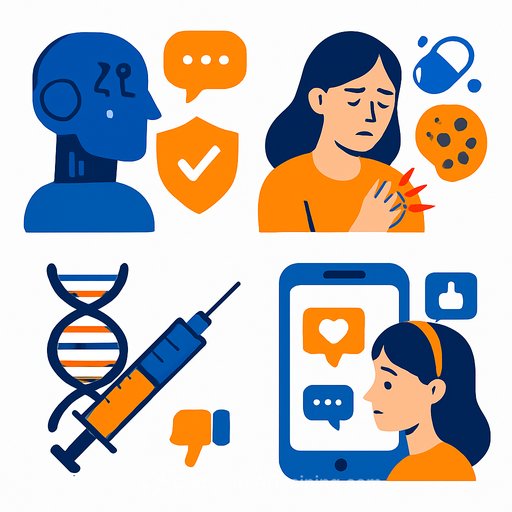TTHealthWatch: What Matters This Week for Healthcare Teams
TTHealthWatch is a weekly podcast from Texas Tech that breaks down the top medical headlines. This week: a dual-pathway therapy for SLE, guardrails for AI in healthcare, lentiviral gene therapy for ADA-SCID, and how rising social media use tracks with lower cognitive performance in adolescents.
1) Dual-pathway therapy shows promise in SLE
A randomized trial in 355 patients with systemic lupus erythematosus evaluated telitacicept, an agent targeting two B-cell activation pathways. Over one year, about 70% of participants on telitacicept met clinical response criteria versus 40% on placebo.
Adverse events were mostly mild: more upper respiratory infections (32% vs 19%), lower serum immunoglobulins, and injection-site reactions. No increase in severe events was reported. The signal is encouraging for patients with partial or no response to single-pathway biologics, but longer follow-up is essential to clarify sustained benefit, infection risk, and optimal positioning alongside steroids, antimalarials, and other immunosuppressants.
- Clinical takeaway: For moderate-to-severe SLE, dual-pathway B-cell inhibition could broaden response rates. Monitor infection risk and immunoglobulin levels if adopted post-approval.
2) AI in healthcare: oversight, measurement, and accountability
AI is already embedded across care delivery: imaging, scheduling, documentation, clinical decision support, scribing, and mobile health. Many tools sit outside traditional FDA oversight, while others are cleared as SaMD. The result: fragmented governance, uneven validation, and unclear institutional accountability.
Key steps emphasized by leaders: engage stakeholders across the full product life cycle; standardize measurement for performance and safety; build a national-quality data infrastructure and learning environment; and align incentives with market forces and policy. Without these, deployment outpaces assurance.
- What to do now:
- Inventory every AI tool in use (clinical, operational, patient-facing). Assign owners.
- Stand up an AI governance committee (clinical, IT, legal, compliance, equity, safety).
- Require pre-deployment evaluation: intended use, data sources, bias/privacy risks, human-in-the-loop design, and fail-safes.
- Set post-deployment monitoring: drift detection, outcome equity audits, incident reporting, version tracking.
- Update vendor contracts: performance benchmarks, transparency on model changes, audit rights, security obligations.
- Train end users and leaders. Clear scope-of-use, documentation, and escalation pathways.
Helpful resources: FDA's overview of AI/ML in SaMD can guide internal standards and vendor evaluation.
FDA: AI/ML in Software as a Medical Device
If your team needs role-specific upskilling for safe, effective AI use, see: AI courses by job.
3) Lentiviral gene therapy for ADA-SCID: durable outcomes
For ADA-deficient severe combined immunodeficiency, lentiviral vector gene therapy delivered strong long-term outcomes in 62 patients with a median follow-up of about 7.5 years. Overall survival was 100%; event-free survival was 95%.
Most discontinued enzyme replacement and immunoglobulin therapy. Patients mounted strong responses to vaccines, and no treatment-related cancers were observed. This positions lentiviral gene therapy as a curative option and a template for other monogenic diseases with enzyme deficiencies, pending continued surveillance.
- Clinical takeaway: For eligible ADA-SCID patients, lentiviral gene therapy offers life-saving, sustained immune reconstitution with a favorable safety profile to date.
NIAID: Severe Combined Immunodeficiency (SCID)
4) Adolescent social media use and cognition
A longitudinal analysis of 6,500+ adolescents (baseline age 9-10) identified three patterns: no/very low use, low-increasing use, and high-increasing use over two years. Both low-increasing and high-increasing trajectories were associated with lower performance in reading-related skills, picture sequence memory, and picture vocabulary compared with very low use.
Mechanisms likely include sleep disruption and displacement of schoolwork and reading. The effect sizes were compared by editorialists to those seen with lead exposure or lack of breastfeeding-signals that historically prompted policy action.
- Clinical and policy actions:
- Screen for social media exposure in pediatric visits; include sleep, school performance, and mood.
- Co-create family media plans: time limits, device-free sleep routines, content oversight.
- Advocate for age-appropriate platform design, data protections, and enforceable time/sleep safeguards.
- Coordinate with schools on digital literacy and reading reinforcement.
Bottom line for healthcare leaders
- SLE: Dual-pathway B-cell targeting may expand responses; plan for infection surveillance and long-term safety tracking.
- AI: Formalize governance, measurement, and monitoring before scale. Treat AI as a clinical quality and safety program, not a tech add-on.
- ADA-SCID: Lentiviral gene therapy provides durable benefit and a path forward for similar genetic conditions.
- Adolescents: Rising social media use correlates with lower cognitive performance. Make screening and guidance routine.
Your membership also unlocks:






